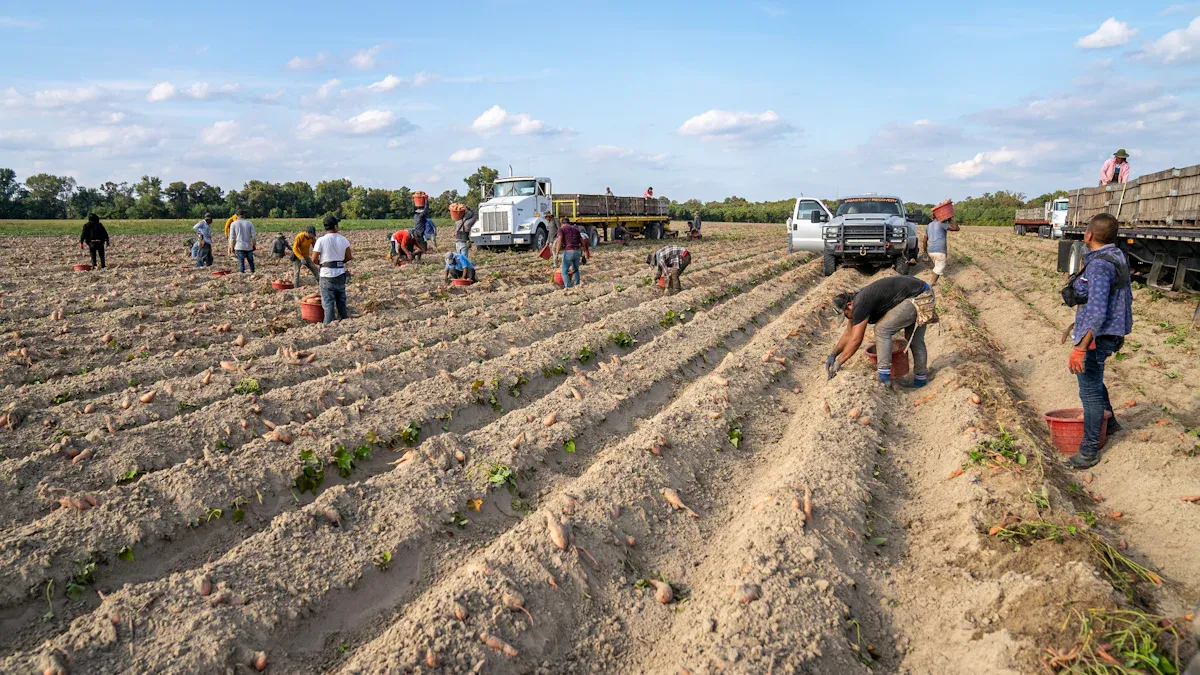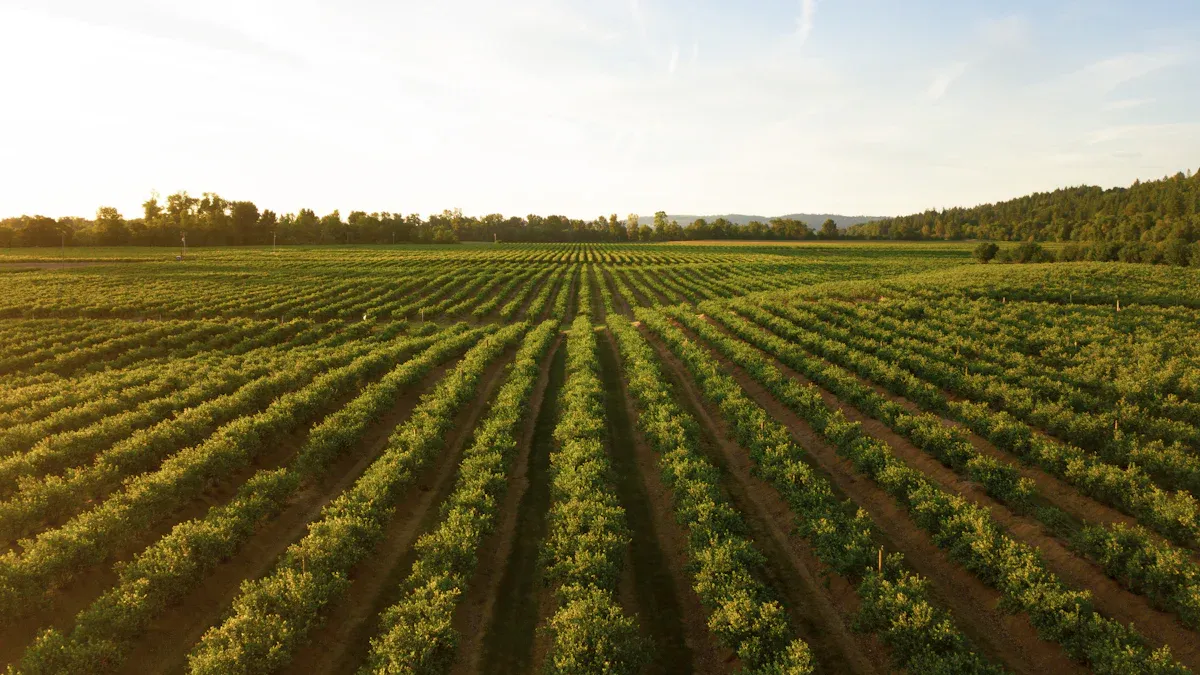
Organic farming is embracing a groundbreaking solution: dried mealworms for farms. These nutrient-rich insects offer a sustainable alternative to traditional protein sources. Producing 1 kg of mealworm protein emits only 20.4 kg CO2-eq, far less than livestock. Their ability to thrive on organic waste and grow vertically reduces land use and energy consumption. North American farms are increasingly adopting this eco-friendly approach to meet sustainability goals while enhancing agricultural efficiency.
Key Takeaways
- Dried mealworms are a green protein option. They release only 20.4 kg of CO2 per kg made, which is better for the environment than regular farm animals.
- Adding mealworms to animal feed improves health and helps them grow faster. This is because mealworms have lots of protein and important nutrients.
- Mealworm frass, used as plant food, makes soil richer. It cuts down on chemical fertilizers and helps keep nature healthy.
What Are Dried Mealworms for Farms?
Dried mealworms for farms are a sustainable and nutrient-dense solution for organic agriculture. These insects, often used as feed supplements, offer a high-protein alternative to traditional livestock feed like soybean meal. Their versatility and environmental benefits make them an attractive option for modern farming practices.
Nutritional Benefits of Dried Mealworms
Dried mealworms provide exceptional nutritional value for livestock. They contain 51.93% protein, which surpasses the 44.51% found in soybeans. Additionally, they are rich in essential amino acids like lysine and threonine, which are often deficient in common cereals such as wheat and maize. These nutrients contribute to healthier livestock and improved feed conversion rates (FCR). Studies, including one by Nassar et al. (2023), highlight how replacing soy with mealworms can lower protein costs and boost farm profitability. However, calcium supplementation may be necessary when feeding mealworms to poultry to prevent deficiencies.
Environmental Advantages of Mealworm Farming
Mealworm farming significantly reduces the environmental footprint of protein production. A life cycle assessment by Dreyer et al. (2021) revealed that producing 1 kg of edible mealworm protein emits only 20.4 kg of CO2 equivalent, far less than traditional livestock farming. Mealworms also require minimal land and energy, with only 22.38 m² of agricultural land occupation and 213.66 MJ-eq of non-renewable energy use. These metrics demonstrate their potential to address the environmental challenges of conventional farming.
Applications in Organic Agriculture
Organic farms use dried mealworms for various purposes. As a feed supplement, they enhance livestock health and productivity. Their nutrient-rich composition also supports soil fertility when used as compost or fertilizer. By integrating mealworms into farming systems, you can promote ecosystem balance and align with sustainable agricultural practices. This innovative approach helps farms reduce reliance on resource-intensive inputs while maintaining high standards of organic production.
Why Organic Farms Are Turning to Mealworm Supplements

Enhancing Livestock Health and Nutrition
You can significantly improve livestock health by incorporating dried mealworms for farms into their diets. These insects provide a high-protein feed source, with protein content ranging from 40.7% to 52.3% when reared on agro-industrial by-products. This makes them an excellent alternative to soy-based feeds. Mealworms also enhance growth rates and overall animal health, as their nutrient profile includes essential amino acids that support optimal development. By using mealworms, you can ensure your livestock receives a sustainable and nutrient-rich diet while reducing dependency on traditional protein sources.
Promoting Soil Fertility and Ecosystem Balance
Mealworm-based amendments can transform soil health on your farm. Research shows that yellow mealworm frass improves soil fertility more effectively than synthetic fertilizers or animal manure.
Soil treated with mealworm frass exhibits higher levels of nitrogen (N), phosphorus (P), potassium (K), and soil organic carbon (SOC) stocks.
This nutrient boost enhances soil structure and microbial activity, creating a balanced ecosystem. By using mealworm frass as compost, you can reduce chemical inputs and promote long-term soil health, aligning with organic farming principles.
Aligning with Sustainable Farming Goals
Dried mealworms for farms align perfectly with sustainable agriculture. They produce fewer greenhouse gas emissions (3.8 kg CO2 equivalent) compared to traditional livestock feed. Their cultivation requires minimal land (4.1 m²) and energy (141.3 MJ) per kilogram of protein. Additionally, mealworms efficiently convert food waste into protein-rich biomass, reducing agricultural waste. By adopting mealworm supplements, you can lower your farm’s environmental footprint while meeting sustainability goals. This innovative approach supports eco-friendly practices without compromising productivity.
Key Benefits of Dried Mealworms for Farms
Lower Environmental Impact Compared to Traditional Protein Sources
Using dried mealworms for farms significantly reduces the environmental footprint of protein production. Mealworms require less land, water, and energy compared to traditional livestock. For example, producing 1 kg of mealworm protein emits only 20.4 kg CO2-eq, while beef production emits much higher greenhouse gases. Mealworms also use just 22.38 m² of land per kilogram of protein, far less than cattle or poultry.
Environmental Comparison:
- Water footprint: Mealworms (4341 m³/t) vs. Beef (15100 m³/t).
- Land requirement: Mealworms use less land than beef or chicken.
- Ammonia emissions: Mealworms produce significantly lower emissions.
By choosing mealworms, you can reduce your farm’s greenhouse gas emissions and resource use, aligning with sustainable farming practices.
Efficient Resource Utilization in Mealworm Cultivation
Mealworms excel in resource efficiency. They convert feed into protein more effectively than traditional livestock. High-protein diets for mealworms enhance their growth and survival rates, reducing production time. Additionally, mealworms thrive on organic waste, turning it into valuable protein. This not only minimizes waste but also supports circular economy principles.
A life cycle assessment shows that mealworm farming requires less energy (213.66 MJ-eq) and land compared to cattle farming. By adopting mealworm cultivation, you can achieve higher productivity with fewer resources.
Boosting Farm Productivity and Economic Viability
Dried mealworms for farms offer economic advantages. Their high protein content (51.93%) surpasses soybeans (44.51%), leading to better feed efficiency and growth performance in livestock. Mealworms also cost less to produce, especially when fed organic waste.
| Aspect | Mealworms | Soybeans |
|---|---|---|
| Protein Content | 51.93% | 44.51% |
| Feed Efficiency | Higher | Lower |
| Cost of Production | Less expensive | More expensive |
| Space Requirement | Requires less | Requires more |
By incorporating mealworms into your farm, you can reduce feed costs, improve livestock health, and increase profitability.
Challenges in Adopting Mealworm Supplements
Cost and Scalability of Production
Scaling mealworm production to meet market demand presents significant challenges. High production costs remain a major barrier for many farms. For instance, producing 50 grams of freeze-dried mealworms costs approximately 4.85 € in the Netherlands, translating to 32.33 €/kg when rehydrated. This price is comparable to meat but less competitive than traditional protein sources like soybean meal. Additionally, mealworm farming requires specialized infrastructure, which increases initial investment costs.
Despite these hurdles, mealworm production offers long-term environmental benefits. It uses less land and emits fewer greenhouse gases compared to conventional protein sources. However, achieving cost parity with established feeds like fishmeal or soy remains a critical challenge for widespread adoption.
Overcoming Consumer Skepticism
Consumer resistance significantly slows the adoption of mealworm supplements. Many individuals hold cultural biases against using insects as feed or fertilizer. This resistance is particularly strong in regions like Europe, where perceptions of insects as pests overshadow their benefits. A lack of awareness about the nutritional and environmental advantages of mealworms further compounds the issue.
To address this, you can focus on educating consumers about the benefits of mealworm-based solutions. Highlighting their role in sustainable farming and showcasing successful case studies can help shift public opinion. Building trust through transparent practices and certifications also plays a crucial role in overcoming skepticism.
Navigating Regulatory and Certification Hurdles
Regulatory barriers create additional obstacles for mealworm supplements. The approval process for these products is lengthy, often taking five to six years. This slow pace hinders market entry and delays commercial expansion.
| Challenge/Progress | Description |
|---|---|
| Slow Approval Process | Applications for mealworm-based supplements take years to gain approval. |
| Regulatory Barriers | Complex regulations limit market growth and discourage new producers. |
| Funding Difficulties | Research funding is scarce, especially in regions where insects lack priority. |
To navigate these challenges, you must stay informed about regulatory requirements and collaborate with industry stakeholders. Advocating for streamlined approval processes and increased funding for research can also accelerate progress.
Dried mealworms for farms offer a sustainable solution to modern agricultural challenges. They provide high-quality protein, reduce ecological impact, and transform food waste into valuable resources. Their frass enriches soil with essential nutrients, promoting plant growth. By adopting mealworm-based practices, you can revolutionize farming while supporting global sustainability goals.
🌱 Tip: Explore mealworm supplements to enhance your farm’s productivity and environmental stewardship.
FAQ
What are the main uses of dried mealworms on organic farms?
Dried mealworms serve as livestock feed, soil amendments, and compost enhancers. They improve animal health, boost soil fertility, and align with sustainable farming practices.
Are dried mealworms safe for livestock consumption?
Yes, dried mealworms are safe. They provide essential nutrients like protein and amino acids, supporting livestock growth and health when properly integrated into diets.
How can mealworm frass benefit soil health?
Mealworm frass enriches soil with nitrogen, phosphorus, and potassium. It boosts microbial activity, improves soil structure, and reduces reliance on synthetic fertilizers.


